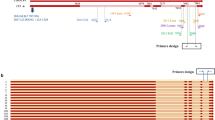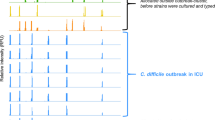Abstract
A rapid polymerase chain reaction (PCR) method for detection of toxigenicClostridium difficile directly from fecal samples by amplification of toxin Agene fragments was investigated. The technique was applied to monitor the spread of the microorganism in a long-term care ward with a relatively high incidence of overt episodes of diarrhea. The PCR approach has several advantages over traditional methods, rapidly allowing the specific detection of toxigenicClostridium difficile strains from stool samples in both symptomatic and asymptomatic subjects with toxigenic strains. This PCR method allows early detection of toxigenicClostridium difficile and could thus represent a powerful tool for the surveillance of epidemics.
Similar content being viewed by others
References
Bartlett JG:Clostridium difficile: clinical considerations. Reviews of Infectious Diseases 1990, 12, Supplement 2: 243–251.
Borriello SP, Davies HA, Kamyia S, Reed PJ, Seddon S: Virulence factors ofClostridium difficile. Reviews of Infectious Diseases 1990, 12, Supplement 2: 185–191.
Fekety R, Shah AB: Diagnosis and treatment ofClostridium difficile colitis. Journal of the American Medical Association 1993, 269: 71–75.
De Girolami PC, Hanff P, Eichelberger K, Longhi L, Teresa H, Pratt J, Cheng A, Letoumeau JM, Thome GM: Multicenter evaluation of a new enzyme immunoassay for detection ofClostridium difficile enterotoxin A. Journal of Clinical Microbiology 1992, 30: 1085–1088.
Lyerly DM, Wilkins TD: Commercial latex test forClostridium difficile toxin A does not detect toxin A. Journal of Clinical Microbiology 1986, 23: 622–623.
Nguyen WK, Rihn B, Heckel C, Bisseret F, Girardot R, Monteil H: Enzyme immunoassay (ELISA) for detection ofClostridium difficile toxin B in specimens of faeces. Journal of Medical Microbiology 1990, 31: 251–257.
Fluit ADC, Wolfhagen MM, Verdonk GT, Jansze M, Torensma R, Verhoef J: Nontoxigenic strains ofClostridium difficile lack the genes for both toxin A and toxin B. Journal of Clinical Microbiology 1991, 29: 2666–2667.
Borriello SP, Wren BW, Hyde S, Seddon SW, Sibbons P, Krishna MMM, Tabaqchali S, Manek S, Price AB: Molecular, immunological and biological characterization of a toxin A-negative, toxin B-positive strain ofClostridium difficile. Infection and Immunity 1992, 60: 4192–4199.
McFarland LV, Surawicz CM, Stamm WE: Risk factors forClostridium difficile: carriage andC. difficile-associated diarrhea in a cohort of hospitalized patients. Journal of Infectious Diseases 1990, 162: 678–684.
Gumerlock PH, Tang YJ, Meyers FJ, Silva J: Use of the polymerase chain reaction for the specific and direct detection ofClostridium difficile in human feces. Reviews of Infectious Diseases 1991, 13: 1053–1060.
Kato N, Ou CY, Kato H, Bartley SL, Luo CC, Killgore GE, Oueno K: Detection of toxigenicClostridium difficile in stool specimens by the polymerase chain reaction. Journal of Infectious Diseases 1993, 167: 455–458.
Trani G, Arzese A, Minisini R, Botta GA: Valutazione comparativa di metodiche per la determinazione delClostridium difficile e delle sue tossine in uno studio di sorveglianza. In: Proceedings SIMMOC Congress, Société Italiana Microbiologia Medica Odontoiatrica e Clinica Publishing, Pisa, 1993, p. 76.
Ulrich PP, Romeo JM, Lynton JD, Girish NV: An improved method for the detection of hepatitis C virus RNA in plasma utilizing heminested primers and internal control RNA. PCR Methods and Application 1993, 2: 241–249.
Wilson KH, Kennedy MJ, Fekety FR: Use of sodium taurocholate to enhance spore recovery on a medium selective forClostridium difficile. Journal of Clinical Microbiology 1982, 15: 443–446.
Lyerly DM, Krivan HC, Wilkins TD:Clostridium difficile: its disease and toxins. Clinical Microbiology Reviews 1988, 1: 1–18.
Gumerlock PH, Tang YJ, Weiss TB, Silva J: Specific detection of toxigenic strains ofClostridium difficile in stool specimens. Journal of Clinical Microbiology 1993, 31: 507–511.
Kuhl SJ, Tang YJ, Navarro L, Gumerlock PH, Silva J: Diagnosis and monitoring ofClostridium difficile infections with the polymerase chain reaction. Clinical and Infectious Diseases 1993, 16: S234-S238.
Author information
Authors and Affiliations
Rights and permissions
About this article
Cite this article
Arzese, A., Trani, G., Riul, L. et al. Rapid polymerase chain reaction method for specific detection of toxigenicClostridium difficile . Eur. J. Clin. Microbiol. Infect. Dis. 14, 716–719 (1995). https://doi.org/10.1007/BF01690883
Issue Date:
DOI: https://doi.org/10.1007/BF01690883




